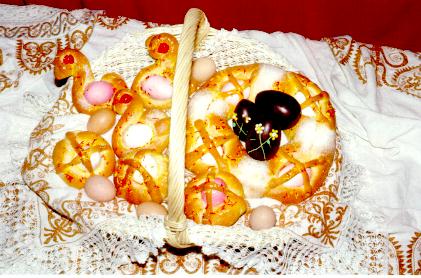La Mona de Pasqua
|
Easter is considered by the people as one of the most solemn festivals Christian year as the popular song says. |
"The fifth festival
Christmas
and Easter
are the best of the year"
|
The early Christians called it "The
Feast of all Feasts" or "The Solemnity of all the solemnities"
as the considered it the sublime identity of the Son of God with the
Holy mother church. This feast incarnates the Holy Word by which
He came to live among men, to redeem the human race and give back
all that was lost through Adams sin. The anniversary of this happening is celebrated every year with satisfaction and it is happiest, most brilliant day of all the year. According to the Catholic Church Easter
is celebrated precisely on the first Sunday after the full moon after
the 20th of March and Lent. Easter is the holiday which children look
forward to because they receive a present of the traditional "Easter
Cake" from their godparents, following an old tradition. The
present is a cake of different shapes with boiled egg on top..
This cake is called "Mona" - monkey - because the say the first ones had the shape of that animal or put a monkey figure on top. The tradition of eggs is because in almost
all ancient countries, the egg was the symbol of the Creator a summary
of all the things created. The Greeks and Romans offered them to their
divinities when they wanted to purify themselves and they were served
at funeral feasts to purify the souls of the dead. In early Christian times with Lent and its
Ecclesiastic discipline it was forbidden to eat not only meat and
milk but also eggs. Because of this abstinence during that period
there was an extraordinary store of eggs and to better conserve them,
they cooked them or covered the shell with chalk to preserve them. Christians continued giving the egg the
symbolic meaning of the divinity to represent the resurrection of
Jesus Christ and the decorated them with many colours. Red was the
most common in remembrance of the blood spilt by the Redeemer on the
cross. On Easter Saturday they took them to be blessed and give large
quantities as a present to families and friends. We must understand that this Easter custom
is of very primitive origin and it represents the renewal of nature
and giving presents of painted eggs or golden ones remembers the beginning
of all things, an idea or belief that persisted in some European countries
when the tradition was to began the year at Easter, motivating the
tradition of giving presents in this festivity. Still, the custom probably stems from the
ancient Hebrews, who started the year at Easter in remembrance of
their freedom from captivity which was for them the most important
of their history. Since the Christians found in the Ancient Law similarities
with the Law of Grace, they commemorated and practise certain religious
ceremonies at festivals similar to the Old Testament. We know that
the children of Israel made unleavened bread and cakes at Easter,
using the first flour of the harvest. They made presents of this bread to their
loved ones. So it is almost certain that these presents
were the origin of what we call "the Mona", an appropriate
word since the Latin "Munus" means gift or present and "the
Mona" is eaten not by the person who buys it but by the person
who receives it as a present. The Muslims who once inhabited the kingdom
of Valencia understood the word "Muna" to mean the tax that
they paid for renting the land at certain times of the year, a tax
which consisted in cakes, agricultural produce and boiled eggs. The word "Muna" with time became
"Mona" and the Moroccans still use these word. This word means Easter present. Once there was the tradition for the cake
to have as many eggs as years of age of the God Son presented by the
God Father, so showing the receiver's age. This continued until the
boy or girl became of age. Traditions evolve and change and now the
cakes have disappeared and Easter presents can be different objects. |
